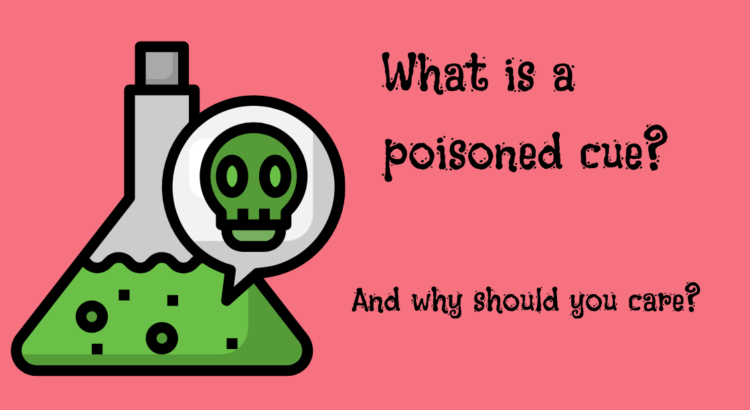by Joan Orr M.Sc., TAGteach Cofounder
What is a Cue Anyway?
Before we talk about poisoned cues, we need to understand about healthy cues. A cue is a signal to a person or animal that lets them know it’s go time. It tells them that the behavior they perform after perceiving the cue will result in a win for them. For example the starting gun at the olympics tells the runners it’s time to explode off the starting blocks for the chance to run and win. A green light tells a driver it’s time to press on the accelerator and continue on their journey. If your dog comes running when they hear the rustle of the potato chip bag, they’ve learned that this sound is a cue to come to you in the hope that you’ll share. Cues become learned through repeated association with the positive consequence that follows the cue + behavior sequence.
In the world of TAGteach and positive reinforcement based training, the cues that we teach our learners are always intended to be these healthy types of cues. That is, a good thing always happens when the learner responds to the cue with the desired behavior. The cue is great news to the learner and they joyfully execute the behavior that is associated with the cue.
The cue is perceived as an opportunity to earn positive reinforcement.
A sure sign of a healthy cue is that the person or animal responds to the cue right away, with accuracy and enthusiasm.
What is a Poisoned Cue?
A poisoned cue is not such great news for the learner. It comes with some ambiguity and uncertainty. Signs of a poisoned cue include a slow response, lack of enthusiasm, declining accuracy or even avoidance or lack of response.
A cue becomes poisoned when it becomes associated with something unpleasant and the learner doesn’t know for sure what will come next – a good thing or a not so good thing.
For example, say you give your puppy the cue “sit” and when he sits you give him a treat. You repeat this a bunch of times in a row. This would establish a healthy cue. But one time he gets distracted and doesn’t sit right away, so you push down on his rear to force him to sit. This happens again the next time as well. Now the puppy hears the cue “sit” and he’s not sure whether you’re going to push on his rear or not. The pure joy that was previously associated with the cue is replaced with uncertainty.
“We Need to Talk”
This phrase is a poisoned cue for many people, resulting in all kinds of anxiety and over-thinking… “am I getting a raise?”, “are they breaking up with me?”, “did I do something great?”, “did I do something wrong?”. Our past history with whatever has come after this phrase will determine our response. Will we rush over to our coach, spouse or boss with anticipation of the great thing that is about to happen or will we take our time while trying to figure out what we may have done right or wrong recently? Does this phrase spark joy in our hearts or cause stress and anxiety? It all depends on whether this phrase is a healthy or a poisoned cue. If this phrase has sometimes signaled something good and sometimes something bad, then it’s a poisoned cue for us.
How Do Poisoned Cues Affect Training and Relationships?
Poisoned cues hinder training and negatively affect relationships. Both people and animals respond best when they are rewarded for their efforts and when the cues they perceive are consistently associated with good things. When there is an adverse event associated with the cue some of the time and a positive event associated with the cue some of the time, this causes uncertainty, anxiety and loss of trust. Keeping cues healthy takes planning and discipline, but it’s well worth the effort to maintain the joy in both the performance and the relationship.
Join Us for a Webinar with Steve White

NOTE: if the date for this is in the past – you can still register to see the recording
Join Steve to learn how to identify poisoned cues, how to avoid them in your teaching and training and how to cure them if they manage to creep in.
Cues are precious and fundamental to all training. In this webinar you’ll learn about the dreaded poisoned cue, how it can hurt your training and your relationship with your learner, and how to prevent and fix poisoned cues.
You’ll learn…
– What poisoned cues are
– How they are created
– How they create an adverse feedback loop between learner and teacher
– How to identify your own poisoned cues that interfere with your training
– How to use TAGteach principles to detox both ends of the leash.
